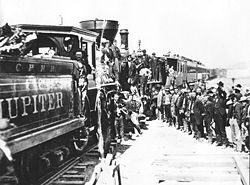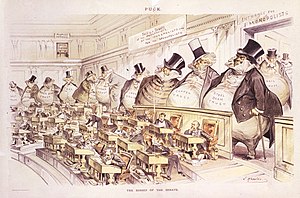Gilded Age
 From RationalWiki - Reading time: 7 min
From RationalWiki - Reading time: 7 min
| God, guns, and freedom U.S. Politics |
| Starting arguments over Thanksgiving dinner |
| Persons of interest |
The Gilded Age is variously said to have begun around the end of the American Civil War to the end of Reconstruction, and ended somewhere between 1893 (using the Panic of 1893 as a bookend) and 1900. While the Industrial Revolution had already begun, it was during this period that the USA truly moved toward an industrial manufacturing base rather than an agricultural one. Some of the famous people from this period should be familiar to people who have studied American history: Andrew Carnegie,[note 1] John Rockefeller,[note 2] Cornelius Vanderbilt,[note 3] JP Morgan,[note 4] and Samuel Gompers.[note 5] It is also the time when the nation overtook the United Kingdom as the world's industrial powerhouse, in part due to the south finally being brought into the industrial age, and some of the South's de facto slaves migrating to the less racist Northern cities.
The "Gilded Age" moniker comes from the title of the book The Gilded Age: A Tale of Today by Mark Twain and Charles Dudley Warner, written in 1873. The "gilding" is supposed to represent the opulent "golden" facade of the era which hid the rotten core. It's common to portray the Gilded Age as a golden age (ironic considering what we just said) of magnificent technological advancement or a dark age of complete corruption. Like so many other eras, it had its ups and downs and the real picture lies somewhere between both of these caricatures. Carnegie, for one, was representative of the period in many ways. He was one of the most innovative businessmen in history but approved egregious anti-labor tactics behind closed doors as in the Homestead Strike![]() .
.
Things we got[edit]
- "Captains of Industry" or "Robber Barons," depending on your political perspective.
- Trusts, also known as cartels. (Yay to the free market!)
- Railways everywhere, and, as a result, modern timekeeping. To avoid collisions and increase efficiency, railroad companies introduced standardized time systems, then nicknamed railway time, and pushed the development of much more accurate timepieces (watches).
- The AFL (American Federation of Labor, not American Football League), and the birth of organized labor as a whole, perhaps as a response to the domination of the working class by the Captains of Industry, which later became the AFL-CIO after it merged with the Congress of Industrial Organizations.
- The Y.
- Social Darwinism.
- The
Starvation ArmySalvation Army. - The fastest period of economic growth for the US,[1] despite which parts of the era are now referred to as the Long Depression
 (see below).
(see below). - Urbanization.
- Taylorism.
- Private defense agencies.
- Changing gender roles. Women working in agriculture had been integrated into the workforce to some degree as they often worked alongside men on farms. With increasing industrialization, women stayed home while the men went out to work. However, the invention of the sewing machine made domestic work easier and more young women achieved financial independence due to new job opportunities, most often at textile mills. It was in this milieu that the suffrage and women's labor movement was born (many looked back to the similar experiences of the Lowell Mill Girls earlier in the century.[2]) This did not really come into play until World War I, when women went into factories to support the war effort, in the absence of the men (who were overseas
dying in holesfighting in ditches). - The Klan.
- Sterilization in surgeries.
Libertarian crankery[edit]
Because of the fact that the Gilded Age was one of low taxes and tariffs and little regulation, it is often brought up as a counter-example to libertarian pipe dreams. Some libertarians will dismiss it as cronyism of the spoils system and political bribery,[note 6] just as many commies disown Soviet Russia. Others, again, recast the Gilded Age as a golden age.[note 7] Of course, they always think they will be the next J.P. Morgan, rather than a coal miner or meat packer. Let's take a look at some ways in which the Gilded Age was not so pleasant:
- Labor wars. Strikes and outbreaks of violence became more common as a result of unsafe work conditions and low pay.[3] In fact, times were such that employers could—and did—hire/bribe police to directly attack striking workers, sometimes even supplying axe handles to assist them (and leave no ambiguity about how they expected the strike to be broken).
- Jim Crow laws.
- Private defense agencies, a favorite "theoretical" means of privatizing law enforcement proposed by some libertarians, actually existed during this period. They were mostly used as espionage agents to spy on and prevent the organization of labor as well as strikebreakers (i.e., private armies, "Pinkertons"). For the logical extension of the private law enforcement, see the Death Specials.[4]
- While the period overall saw unprecedented economic growth, as aforementioned it also contained the longest recorded economic contraction in US history. (65 months, to be exact. For comparison, the 1929-1933 contraction during the Great Depression lasted "only" 43 months.)[5] It was actually this depression, lasting from 1873-1879, that was originally called the "Great Depression," and subsequently renamed the "Long Depression."[note 8] The Panic of 1873 was caused by a banking crisis in Europe, which spread its financial contagion to the US and popped a financial and railroad bubble, leading to the market crash.[6] Some libertarians will cherry-pick statistics (such as the continuous decline in prices since the Civil War and expansion of monetary base) to bullshit the depression out of existence. However, they ignore the beating that wages took and the overall decline in growth during this period.[7] The business cycle during this era became exceptionally harsh. While the economy generally boomed again in the US in the 1880s, it still suffered periods of contraction from 1883-1885 and 1887-1888. Two more large-scale bank panics would come in the 1890s, with the Panics of 1893 and 1896. This backdrop of wild economic swings (which hurt farmers especially) set the stage for the rise of the Free Silver movement, populist candidates like William Jennings Bryan, and eventual attempts at stabilization such as the Federal Reserve.
- Virtually non-existent safety laws and regulations.[8] Got your legs chopped off in an industrial accident? There's no workman's compensation, so you most likely better get used to panhandling. Not to mention the progressive illnesses you might not even know you had until later in life, like phossy jaw.
 Oh boy! Also, you'd better hope your industrial accident didn't damage the machinery, or your (now erstwhile) employer was likely to bill you for the damage - and the courts would back him up.
Oh boy! Also, you'd better hope your industrial accident didn't damage the machinery, or your (now erstwhile) employer was likely to bill you for the damage - and the courts would back him up. - Child labor. Libertarians like to claim that increasing wealth caused child labor to disappear to a great extent during this period. However, to what extent the decline in child labor over the period of the 1880s to the 1920s was economic or social in nature is still in dispute (especially depending on the location and industry) and the Industrial Revolution itself drove demand for child labor (kids could reach into the nooks and crannies, and you didn't have to pay 'em as much!). Child labor was not fully cracked down on until the Great Depression.[9] Ironically, the free marketeers of the time argued that child labor was pretty damn awesome because it "built character" (though strangely, few of them put their own children to work), and to restrict child labor would be an infringement on their economic freedom, ultimately leading to economic doom!
- Company towns
 , which were often little more than shantytowns and tent cities where the company dictated everything: You were paid with company scrip, shopped at company stores, voted for the company-approved candidate, and, in some cases, were told when it was time for lights out at night. Sound familiar?
, which were often little more than shantytowns and tent cities where the company dictated everything: You were paid with company scrip, shopped at company stores, voted for the company-approved candidate, and, in some cases, were told when it was time for lights out at night. Sound familiar? - The market did not, in fact, drive all economic growth. Railroads, those great hubs of industrialization, were built with the aid of federal land grants and subsidies such as those enacted by the Pacific Railway Acts,
 not to mention large-scale interventionism abroad, especially in the Caribbean and Central America, which literally gave the monopoly over lives and politics to a number of US-backed companies.
not to mention large-scale interventionism abroad, especially in the Caribbean and Central America, which literally gave the monopoly over lives and politics to a number of US-backed companies.
External links[edit]
- The Gilded Age, University of Houston
Notes[edit]
- ↑ Introduced a method of producing steel that made it cheap enough to be viable, which was crucial for building cities up as they were hitting peak population density for the height of buildings beforehand.
- ↑ The richest person in American history, his net worth peaked at $340 billion adjusted to inflation, and at one point he controlled 1.5% of America's economic output, he had a virtual monopoly over the oil industry (and this was BEFORE automobiles were introduced to the then-emerging middle class).
- ↑ Owned a railroad empire.
- ↑ Banking philanthropist responsible for the founding of several modern day corporations, such as General Electric and AT&T.
- ↑ A leader of the then-emerging labor movement.
- ↑ As well as due to both the presence of economical protectionism, and (for non US libertarians at least) the existence of gummint-backed central banks in so many countries
- ↑ Rather than gold plated. See, e.g. Adventures in Libertarian Blind Spots
- ↑ The Long Depression often, globally, refers to the period 1873-1896. The depression hit different nations at different points and affected them in different ways, naturally. The US went into a boom after it lifted out of depression in 1879, which helped its economy overtake that of the UK which saw more stagnation during this period. The US economy would not completely nosedive again until 1893. The numerous ups and downs have led it to be characterized as a "long-wave depression."
References[edit]
- ↑ Industrialization and Economic Growth, Saylor Foundation
- ↑ The Lowell Mill Girls Go On Strike, 1836, George Mason University
- ↑ The War between Capital and Labor
- ↑ https://edgeofthewest.wordpress.com/2008/10/17/death-special/
- ↑ US Business Cycle Expansions and Contractions, NBER data
- ↑ The Depression of 1929 is the wrong model for the current economic crisis, Scott Reynolds Nelson
- ↑ For a fuller treatment, see David Glasner and Thomas F. Cooley. "Crisis of 1873" in Business Cycles and Depressions: An Encyclopedia (1997), and Philip Sidney Bagwell and G. E. Mingay. Britain and America, 1850-1939: A Study of Economic Change (1970).
- ↑ Factory Inspection Legislation, US Department of Labor
- ↑ See for a brief overview of working conditions The History of Child Labor in the United States: Hammer v. Dagenhart by Sharron Solomon-McCarthy; a case study of canneries, Martin Brown, Jens Christiansen, and Peter Philips. The Decline of Child Labor in the US Fruit and Vegetable Canning Industry: Law or Economics. The Business History Review, Vol. 66, No. 4, Winter 1992; and a comparison with the UK, Child Labor During the British Industrial Revolution, Carolyn Tuttle, Economic History Association.
 KSF
KSF
